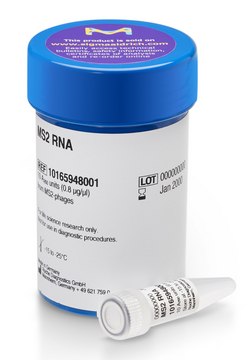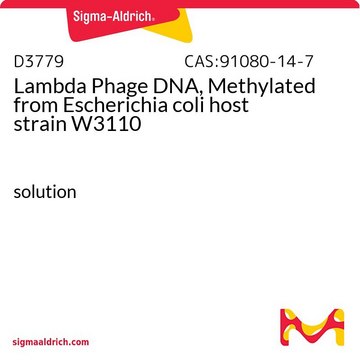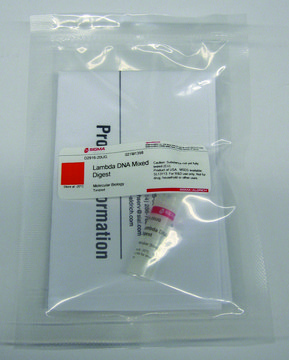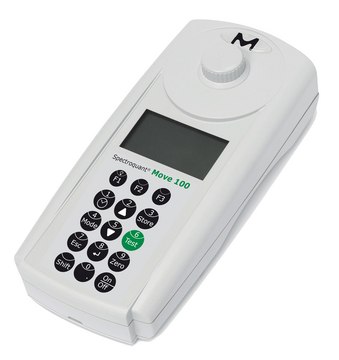推荐产品
特异性
Unique Restriction Sites (Methylated DNA) are: Apa I,Nae I, Nar I, Nhe I, PaeR7 I, SnaB I, Xba I and Xho I.
应用
Lambda Phage DNA, Non-methylated from Escherichia coli host strain GM119 is suitable for use as a substrate for restriction enzymes. It was used as substrate for Prevotella ruminicola DNase activity studies. It was also used as a GC content standard in genome sequencing of 16S rDNA sequences of Cellvibrio japonicas.
Lambda Phage DNA, Non-methylated from Escherichia coli host strain GM119 (rm-,dam-,dcm-) has been used:
- to calibrate spectrophotometer (LKB) and HPLC (high performance liquid chromatography) method for determination of bacterial genomic DNA G+C content
- to amplify the λ; exonuclease gene by polymerase chain reaction (PCR)
- in DNase activities
The lambda phage has an icosahedral head and a long tail terminating in a single fiber. At both ends of the 5′ termini are complementary 12-nucleotide single strand sequences that contribute to the cohesive ends (cos region) of the DNA. The tail of the phage latches on the host outer membrane receptor and injects phage DNA into the cell. The phage converts the E. coli to a lysogenic state in which the phage functions are repressed and the phage genome may remain dormant (prophage) for a long time. This property is seen in bacteriophages that carry CII and CIII genes that are responsible for CI expression. Bacteriophages with CI mutation in the CI gene are able to maintain a lysogenic state at defined temperatures.
Infecting E. coli strain GM 119 with lambda C1857 strain creates E. coli lysogen cultures. The phage is released from E. coli cell pellets by lysing with a high salt buffer, pH 8.0. The crude mixture is passed through a series of enzymatic steps, multiple cesium gradients, and phage DNA is dialyzed against 1 mM Tris-HCl, pH 8.0, and 1 mM magnesium chloride. The DNA is finally extracted by phenol-chloroform solution.
Infecting E. coli strain GM 119 with lambda C1857 strain creates E. coli lysogen cultures. The phage is released from E. coli cell pellets by lysing with a high salt buffer, pH 8.0. The crude mixture is passed through a series of enzymatic steps, multiple cesium gradients, and phage DNA is dialyzed against 1 mM Tris-HCl, pH 8.0, and 1 mM magnesium chloride. The DNA is finally extracted by phenol-chloroform solution.
外形
Phage DNA is isolated from infected E. coli, passed through a series of enzymatic steps before final phenol-chloroform extraction. This non-methylated lambda DNA is completely digested by Bcl I, Cla I, Mbo I, Mbo II, Taq I or Xba I whereas methylated lambda DNA(product number D3779) is only partially cleaved. The unique restriction sites are Apa I,Nae I, Nar I, Nhe I, PaeR7 I, SnaB I, Xba I and Xho I.
底物
Non-methylated lambda DNA is completely digested by Bcl I, Cla I, Mbo I, Mbo II, Taq I or Xba I whereas methylated lambda DNA is only partially cleaved.
储存分类代码
10 - Combustible liquids
WGK
WGK 2
闪点(°F)
Not applicable
闪点(°C)
Not applicable
个人防护装备
Eyeshields, Gloves, type ABEK (EN14387) respirator filter
法规信息
常规特殊物品
Reclassification of `Pseudomonas fluorescens subsp. cellulosa?NCIMB 10462 (Ueda et al. 1952) as Cellvibrio japonicus sp. nov. and revival of Cellvibrio vulgaris sp. nov., nom. rev. and Cellvibrio fulvus sp. nov., nom. rev.
Humphry D R, et al.
International Journal of Systematic and Evolutionary Microbiology, 53(2), 393-400 (2003)
Distribution of restriction endonucleases among some entomopathogenic strains of Bacillus sphaericus
Zahner V and Priest FG
Letters in Applied Microbiology, 24, 483-487 (1997)
Wonseok Hwang et al.
Nature communications, 9(1), 4404-4404 (2018-10-26)
Metal ions at the active site of an enzyme act as cofactors, and their dynamic fluctuations can potentially influence enzyme activity. Here, we use λ-exonuclease as a model enzyme with two Mg2+ binding sites and probe activity at various concentrations
G Avgustin et al.
International journal of systematic bacteriology, 47(2), 284-288 (1997-04-01)
Selected phenotypic characteristics of isolates of Prevotella ruminicola (formerly Bacteroides ruminicola) were studied in order to establish whether the characteristics of genotypic strain groups established previously on the basis of 16S ribosomal DNA sequences differed systematically. Among strains formerly considered
Phenotypic diversity among ruminal isolates of Prevotella ruminicola: proposal of Prevotella brevis sp. nov., Prevotella bryantii sp. nov., and Prevotella albensis sp. nov. and redefinition of Prevotella ruminicola
Avguvstin G, et al.
International Journal of Systematic and Evolutionary Microbiology, 47(2), 284-288 (1997)
我们的科学家团队拥有各种研究领域经验,包括生命科学、材料科学、化学合成、色谱、分析及许多其他领域.
联系技术服务部门






